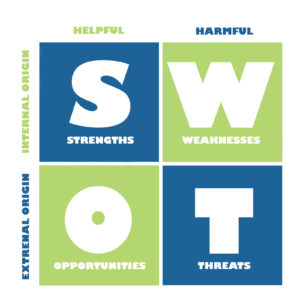When you’ve poured your heart into your business, your focus is automatically drawn to internal operations. Yet, broadening your brand’s reach requires you to look outward to refocus inward. Researching your competitors helps you gain a competitive edge in your industry. It allows you to define the landscape, what’s needed of you to stand out, and where your brand fits in the grand scheme of things. A competitive analysis is just what you need to redesign your marketing playbook.
What Are the Benefits of Performing a Competitive Analysis?
A competitive analysis compares your brand to businesses similar to yours. It’s a research process that uncovers your competitors’ strengths and weaknesses and how they measure against your company. A competitive analysis is used to refocus your marketing strategy, reveal industry trends, and redefine your goals. Some additional benefits include:
- Discover Missed Opportunities: Identify your competition’s weaknesses and use that information to gain an edge, such as lack of product customization.
- Identify Effective Marketing: Study the marketing of industry leaders and see what you can do to challenge their level of success. What is working for them that you haven’t tried yet?
- Find Gaps in the Market: What does your competitor offer? Are they leaving value on the table? Differentiate yourself by diversifying your offerings.
It’s about discovering strategies that’ll help your brand stand out from the rest. But first, you need to execute a proper competitive analysis.
How Do You Perform a Competitive Analysis?
First, identify your competition. This can be as simple as finding local businesses with overlapping offerings or researching leaders in your field. After determining your competitors, you can start your comparison.
Conduct a SWOT Analysis
SWOT is an acronym for Strengths, Weaknesses, Opportunities, and Threats. You want to list business traits that coincide with these factors. Here’s how you should approach each segment:
- Strengths: Where does your organization excel vs. the competition? Does your competition have a strong, loyal consumer base? Do you better integrate technology into sales?
- Weaknesses: Identify areas where you underperform or where your competition is lacking. Does your competition have trouble retaining staff? If so, take advantage by fostering an atmosphere that encourages loyalty.
- Opportunities: What external factors can give you a competitive edge that you have yet to pursue? Is there a blossoming industry trend that you can jump aboard early?
- Threats: These are factors that harm an organization. Has recent legislation made it costlier to perform your services? Are your competitors drastically outpacing you in production?
This is a helpful tool that will uncover the reasoning for your current position in the market. You’ll typically find a SWOT analysis arranged in a square segmented table like this:

Compare Effectiveness of Your SEO
The goal is to appear above your competitor in search engine results, which is why you need to compare your website’s search engine optimization (SEO) to that of your competitors. Comb over their website and count any non-branded industry buzzwords that are missing from your website. You can also document their page loading speed compared to yours and see how dense a catalog of outbound links they provide. All these factors and more contribute to your SEO. To learn how to boost key SEO components, check out our two-part blog, Overhauling Your SEO.
The building blocks of a competitive analysis helps you reconstruct your marketing playbook and guide your company down a more lucrative path. Though, doing all this research can be tricky. At Vision, we have an extensive history of running competitive analyses on behalf of our clients and building a marketing plan based on the results. If you need help getting started, contact us today.




